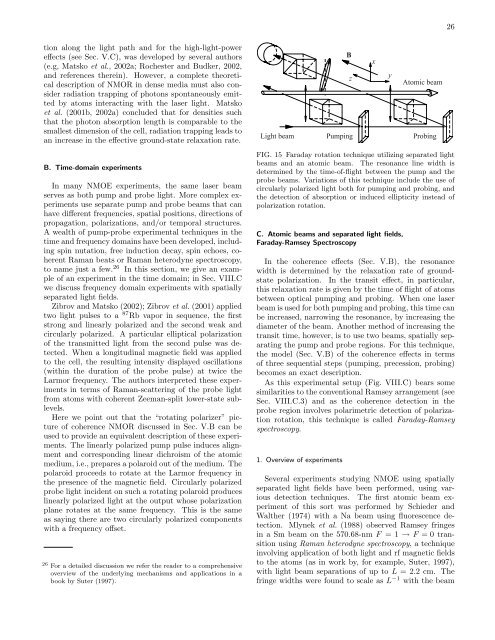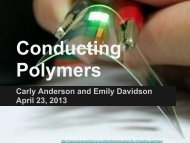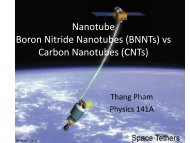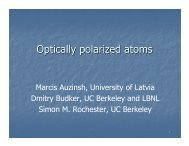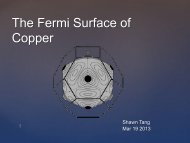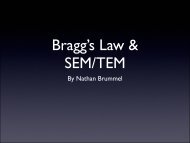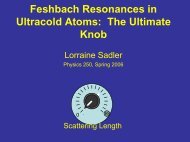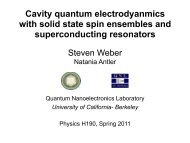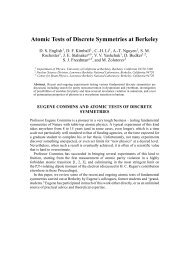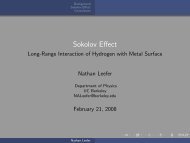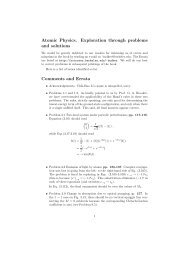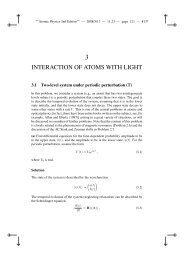Resonant nonlinear magneto-optical effects in atomsâ - The Budker ...
Resonant nonlinear magneto-optical effects in atomsâ - The Budker ...
Resonant nonlinear magneto-optical effects in atomsâ - The Budker ...
Create successful ePaper yourself
Turn your PDF publications into a flip-book with our unique Google optimized e-Paper software.
26<br />
tion along the light path and for the high-light-power<br />
<strong>effects</strong> (see Sec. V.C), was developed by several authors<br />
(e.g, Matsko et al., 2002a; Rochester and <strong>Budker</strong>, 2002,<br />
and references there<strong>in</strong>). However, a complete theoretical<br />
description of NMOR <strong>in</strong> dense media must also consider<br />
radiation trapp<strong>in</strong>g of photons spontaneously emitted<br />
by atoms <strong>in</strong>teract<strong>in</strong>g with the laser light. Matsko<br />
et al. (2001b, 2002a) concluded that for densities such<br />
that the photon absorption length is comparable to the<br />
smallest dimension of the cell, radiation trapp<strong>in</strong>g leads to<br />
an <strong>in</strong>crease <strong>in</strong> the effective ground-state relaxation rate.<br />
B. Time-doma<strong>in</strong> experiments<br />
In many NMOE experiments, the same laser beam<br />
serves as both pump and probe light. More complex experiments<br />
use separate pump and probe beams that can<br />
have different frequencies, spatial positions, directions of<br />
propagation, polarizations, and/or temporal structures.<br />
A wealth of pump-probe experimental techniques <strong>in</strong> the<br />
time and frequency doma<strong>in</strong>s have been developed, <strong>in</strong>clud<strong>in</strong>g<br />
sp<strong>in</strong> nutation, free <strong>in</strong>duction decay, sp<strong>in</strong> echoes, coherent<br />
Raman beats or Raman heterodyne spectroscopy,<br />
to name just a few. 26 In this section, we give an example<br />
of an experiment <strong>in</strong> the time doma<strong>in</strong>; <strong>in</strong> Sec. VIII.C<br />
we discuss frequency doma<strong>in</strong> experiments with spatially<br />
separated light fields.<br />
Zibrov and Matsko (2002); Zibrov et al. (2001) applied<br />
two light pulses to a 87 Rb vapor <strong>in</strong> sequence, the first<br />
strong and l<strong>in</strong>early polarized and the second weak and<br />
circularly polarized. A particular elliptical polarization<br />
of the transmitted light from the second pulse was detected.<br />
When a longitud<strong>in</strong>al magnetic field was applied<br />
to the cell, the result<strong>in</strong>g <strong>in</strong>tensity displayed oscillations<br />
(with<strong>in</strong> the duration of the probe pulse) at twice the<br />
Larmor frequency. <strong>The</strong> authors <strong>in</strong>terpreted these experiments<br />
<strong>in</strong> terms of Raman-scatter<strong>in</strong>g of the probe light<br />
from atoms with coherent Zeeman-split lower-state sublevels.<br />
Here we po<strong>in</strong>t out that the “rotat<strong>in</strong>g polarizer” picture<br />
of coherence NMOR discussed <strong>in</strong> Sec. V.B can be<br />
used to provide an equivalent description of these experiments.<br />
<strong>The</strong> l<strong>in</strong>early polarized pump pulse <strong>in</strong>duces alignment<br />
and correspond<strong>in</strong>g l<strong>in</strong>ear dichroism of the atomic<br />
medium, i.e., prepares a polaroid out of the medium. <strong>The</strong><br />
polaroid proceeds to rotate at the Larmor frequency <strong>in</strong><br />
the presence of the magnetic field. Circularly polarized<br />
probe light <strong>in</strong>cident on such a rotat<strong>in</strong>g polaroid produces<br />
l<strong>in</strong>early polarized light at the output whose polarization<br />
plane rotates at the same frequency. This is the same<br />
as say<strong>in</strong>g there are two circularly polarized components<br />
with a frequency offset.<br />
26 For a detailed discussion we refer the reader to a comprehensive<br />
overview of the underly<strong>in</strong>g mechanisms and applications <strong>in</strong> a<br />
book by Suter (1997).<br />
Light beam<br />
B<br />
z<br />
Pump<strong>in</strong>g<br />
x<br />
y<br />
Atomic beam<br />
Prob<strong>in</strong>g<br />
FIG. 15 Faraday rotation technique utiliz<strong>in</strong>g separated light<br />
beams and an atomic beam. <strong>The</strong> resonance l<strong>in</strong>e width is<br />
determ<strong>in</strong>ed by the time-of-flight between the pump and the<br />
probe beams. Variations of this technique <strong>in</strong>clude the use of<br />
circularly polarized light both for pump<strong>in</strong>g and prob<strong>in</strong>g, and<br />
the detection of absorption or <strong>in</strong>duced ellipticity <strong>in</strong>stead of<br />
polarization rotation.<br />
C. Atomic beams and separated light fields,<br />
Faraday-Ramsey Spectroscopy<br />
In the coherence <strong>effects</strong> (Sec. V.B), the resonance<br />
width is determ<strong>in</strong>ed by the relaxation rate of groundstate<br />
polarization. In the transit effect, <strong>in</strong> particular,<br />
this relaxation rate is given by the time of flight of atoms<br />
between <strong>optical</strong> pump<strong>in</strong>g and prob<strong>in</strong>g. When one laser<br />
beam is used for both pump<strong>in</strong>g and prob<strong>in</strong>g, this time can<br />
be <strong>in</strong>creased, narrow<strong>in</strong>g the resonance, by <strong>in</strong>creas<strong>in</strong>g the<br />
diameter of the beam. Another method of <strong>in</strong>creas<strong>in</strong>g the<br />
transit time, however, is to use two beams, spatially separat<strong>in</strong>g<br />
the pump and probe regions. For this technique,<br />
the model (Sec. V.B) of the coherence <strong>effects</strong> <strong>in</strong> terms<br />
of three sequential steps (pump<strong>in</strong>g, precession, prob<strong>in</strong>g)<br />
becomes an exact description.<br />
As this experimental setup (Fig. VIII.C) bears some<br />
similarities to the conventional Ramsey arrangement (see<br />
Sec. VIII.C.3) and as the coherence detection <strong>in</strong> the<br />
probe region <strong>in</strong>volves polarimetric detection of polarization<br />
rotation, this technique is called Faraday-Ramsey<br />
spectroscopy.<br />
1. Overview of experiments<br />
Several experiments study<strong>in</strong>g NMOE us<strong>in</strong>g spatially<br />
separated light fields have been performed, us<strong>in</strong>g various<br />
detection techniques. <strong>The</strong> first atomic beam experiment<br />
of this sort was performed by Schieder and<br />
Walther (1974) with a Na beam us<strong>in</strong>g fluorescence detection.<br />
Mlynek et al. (1988) observed Ramsey fr<strong>in</strong>ges<br />
<strong>in</strong> a Sm beam on the 570.68-nm F = 1 → F = 0 transition<br />
us<strong>in</strong>g Raman heterodyne spectroscopy, a technique<br />
<strong>in</strong>volv<strong>in</strong>g application of both light and rf magnetic fields<br />
to the atoms (as <strong>in</strong> work by, for example, Suter, 1997),<br />
with light beam separations of up to L = 2.2 cm. <strong>The</strong><br />
fr<strong>in</strong>ge widths were found to scale as L −1 with the beam


